
Uthamar Kovil in Uthamarkoil, a village in the outskirts of Tiruchirappalli in the South Indian state of Tamil Nadu, is dedicated to the Hindu Trimurti of Vishnu, Shiva, and Brahma. Constructed in the Dravidian style of architecture, the temple is glorified in the Nalayira Divya Prabandham, the early medieval Tamil canon of the Alvar saints from the 6th–9th centuries CE. It is one of the 108 Divya Desams dedicated to Vishnu, who is worshipped as Purushothaman Perumal and his consort Lakshmi as Poornavalli Thayar.

Koodal Aḻagar Temple in Madurai, a city in the South Indian state of Tamil Nadu, is dedicated to the Hindu god Vishnu. Constructed in the Dravidian style of architecture, the temple is glorified in the Naalayira Divya Prabandham, the early medieval Tamil canon of the Alvar saints from the 6th–9th centuries CE. It is one of the 108 Divya Desams dedicated to Vishnu, who is worshipped as Viyooga Sundarrajan, and his consort Lakshmi as Mathuravalli.
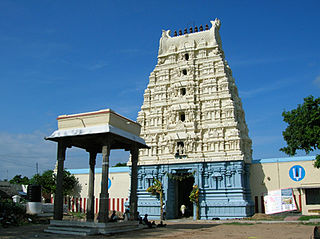
Sri Bhaktavatsala Perumal temple is a Hindu temple, located at Thirunindravur, a western suburb of Chennai, India. It is dedicated to the Hindu deity Vishnu. Constructed in the Dravidian style of architecture, the temple is glorified in the Naalayira Divya Prabandham, the early medieval Tamil canon of the Alvar saints from the 6th–9th centuries CE. It is one of the 108 Divya Desams dedicated to Vishnu, who is worshipped as Bhaktavatsala Perumal and his consort Lakshmi as Ennai Petra Thayar.
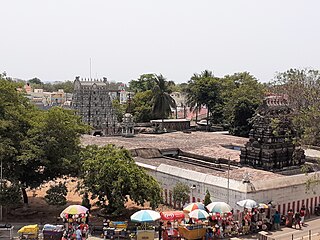
Sthalasayana Perumal Temple is at Mahabalipuram. Constructed in the Dravidian style of architecture, the temple is glorified in the Naalayira Divya Prabandham, the early medieval Tamil canon of the Alvar saints from the 6th–9th centuries CE. It is one of the 108 Divya Desam dedicated to Vishnu, who is worshipped as Sthalasayana Perumal and his consort Lakshmi as Nilamangai Thayar. The temple is believed to have been built by the Pallavas, with later contributions from the Medieval Cholas, Vijayanagara kings, and Madurai Nayaks.

Thirukkadigai or Sholingapuram in Sholinghur, a village in Ranipet district of the South Indian state of Tamil Nadu, is dedicated to the Hindu god Vishnu. Constructed in the Dravidian style of architecture, the temple is glorified in the Naalayira Divya Prabandham, the early medieval Tamil canon of the Alvar saints from the 6th–9th centuries CE. It is one of the 108 Divya Desams dedicated to Vishnu, who is worshipped as Lakshmi Narasimhar, and his consort Lakshmi as Thirumamagal. There are three separate shrines in the form of Narasimha, Bhaktavatsala Perumal and Hanuman (Anjaneya). They are situated on the larger hill, at the base of the larger hill and on the smaller hill, respectively.
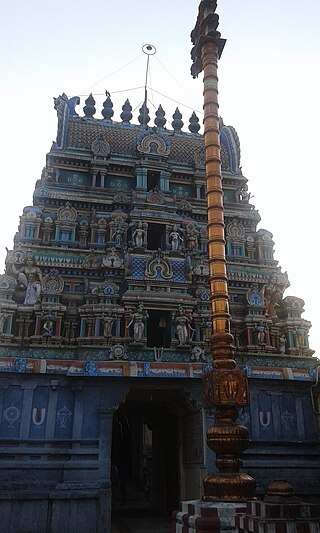
The Devaadi Raja Perumal temple in Therazhundur, a village in Mayiladuthurai district of the South Indian state of Tamil Nadu, is dedicated to the Hindu god Vishnu. Constructed in the Dravidian style of architecture, the temple is glorified in the Naalayira Divya Prabandham, the early medieval Tamil canon of the Alvar saints from the 6th–9th centuries CE. It is one of the 108 Divya Desams dedicated to Vishnu, who is worshipped as Amaruviappan, and his consort Lakshmi as Sengamalavalli Thayar. The original structure of the temple was built by the Karikala Chola during the 1st century CE, with later additions from the Cholas during the 11th century.

Tiruvekkaa Temple or Yathothkari Perumal Temple is a Hindu temple located in Kanchipuram in the South Indian state of Tamil Nadu and dedicated to the Hindu god Vishnu. Constructed in the Dravidian style of architecture, the temple is glorified in the Naalayira Divya Prabandham, the early medieval Tamil canon of the Alvar saints from the 6th–9th centuries CE. It is one of the 108 Divya Desams dedicated to Vishnu, who is worshipped as Yathothkari Perumal, and his consort Lakshmi as Komalavalli. This is the 2nd largest temple in south Kanchi, after the Varadaraja perumal temple.

Thiru Anbil, or Sundararaja Perumal Temple, in Anbil, a village in the outskirts of Tiruchirappalli in the South Indian state of Tamil Nadu, is dedicated to the Hindu god Vishnu. Constructed in the Dravidian style of architecture, the temple is glorified in the Naalayira Divya Prabandham, the early medieval Tamil canon of the Alvar saints from the 6th–9th centuries CE. It is one of the 108 Divya Desams dedicated to Vishnu, who is worshipped as Sundararajan and his consort Lakshmi as Sundaravalli.

Hara Saabha Vimochana Perumal Temple in Thirukandiyur, a village in the outskirts of Thiruvayaru in the South Indian state of Tamil Nadu, is dedicated to the Hindu god Vishnu. Constructed in the Dravidian style of architecture, the temple is glorified in the Nalayira Divya Prabandham, the early medieval Tamil canon of the Alvar saints from the 6th–9th centuries CE. It is one of the 108 Divya Desam dedicated to Vishnu, who is worshipped as Hara Saabha Vimochana Perumal and his consort Lakshmi as Kamalavalli Nachiyar.

The Jagad Rakshaka Perumal Temple or Thirukoodalur in Vadakurangaduthurai, a village in the outskirts of Kumbakonam in the South Indian state of Tamil Nadu, is dedicated to the Hindu god Vishnu. Constructed in the Dravidian style of architecture, the temple is glorified in the Nalayira Divya Prabandham, the early medieval Tamil canon of the Alvar saints from the 6th–9th centuries CE. It is one of the 108 Divya Desams dedicated to Vishnu, who is worshipped as Jakath Rakshaka and his consort Lakshmi as Pushpavalli.

The Adi Jagannatha Temple is a South Indian Hindu temple in Thiruppullani, a village in the outskirts of Ramanathapuram in the South Indian state of Tamil Nadu, is dedicated to the Hindu god Vishnu. It is believed that Rama used grass ('pul' in Tamil as a pillow to sleep and hence the village attained the name Thiruppullani. Constructed in the Cholan style of architecture, the temple is glorified in the Naalayira Divya Prabandham, the early medieval Tamil canon of the Alvar saints from the 6th–9th centuries CE. It is one of the 108 Divya Desam dedicated to Vishnu, who is worshipped as Adi Jagannatha and his consort Lakshmi as Padmasini.
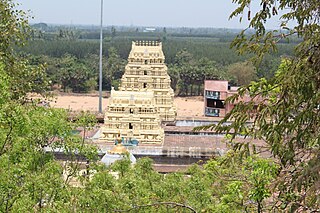
Devanatha Hemabhujavalli Temple (Thiruvaheendrapuram) is a Hindu temple in Thiruvanthipuram, a village in the outskirts of Cuddalore in the South Indian state of Tamil Nadu, dedicated to the god Vishnu and goddess Lakshmi. Constructed in the Dravidian style of architecture, the temple is glorified in the Nalayira Divya Prabandham, the early medieval Tamil canon of the Alvar saints from the 6th–9th centuries CE. It is one of the 108 Divya Desams dedicated to Vishnu, who is worshipped as Devanatha and Lakshmi as Hemabhujavalli. Though the presiding deity is Devanatha and Hemabhujavalli, the temple is known for Hayagriva, the ninth avatara of Vishnu in the Dashavatara of Vishnu and a god of knowledge. The temple is the only historical temple in South India to have a shrine of Hayagriva on hilltop.

Tirupavalavannam or Pavalavanam temple located in Kanchipuram in the South Indian state of Tamil Nadu, is dedicated to the Hindu god Vishnu. Constructed in the Dravidian style of architecture, the temple is glorified in the Nalayira Divya Prabandham, the early medieval Tamil canon of the Alvar saints from the 6th–9th centuries CE. It is one of the 108 Divya Desams dedicated to Vishnu, who is worshipped as Pavalavannar Perumal and his consort Lakshmi as Pavalavalli.

Pandavatutar Perumal Temple or Thirupadagam located in Kanchipuram in the South Indian state of Tamil Nadu, is dedicated to the Hindu god Krishna, an avatar of the god Vishnu. Constructed in the Dravidian style of architecture, the temple is extolled in the Nalayira Divya Prabandham, the early medieval Tamil canon of the Alvar saints from the 6th–9th centuries CE. It is one of the 108 Divya Desams dedicated to Vishnu, who is worshipped as Pandava Tutar Perumal (Krishna) and his consort Lakshmi (Rukmini.)

The Saranathan Temple in Thirucherai, a village on the outskirts of Kumbakonam in the South Indian state of Tamil Nadu, is dedicated to the Hindu god Vishnu. The temple is glorified in the Nalayira Divya Prabandham, the early medieval Tamil canon of the Alvar saints from the 6th–9th centuries CE. It is one of the 108 Divya Desams dedicated to Vishnu, who is worshipped as Saranathan and his consort Lakshmi as Saranayaki. It is believed that Saranathan appeared for Kaveri, the river goddess, who performed penance at this place.

Ulagalantha Perumal Temple or Trivikrama Temple is a Hindu temple dedicated to Vishnu located in Tirukkoyilur, Tamil Nadu, India. Constructed in the Dravidian style of architecture, the temple is glorified in the Naalayira Divya Prabandham, the early medieval Tamil canon of the Alvar saints from the 6th–9th centuries CE. It is one of the 108 Divya Desams dedicated to Vishnu, who is worshipped as Ulagalantha Perumal and his consort Lakshmi as Poongothai. The temple is believed to have been built by the Medieval Cholas, with later contributions from Vijayanagara kings and Madurai Nayaks. The temple covers an area of 5 acres (20,000 m2) and has a temple tower that is the third tallest in Tamil Nadu, measuring 192 ft (59 m) in height.

The Madhava Perumal Temple is dedicated to Hindu deity Vishnu, located in Mylapore, Chennai, in the South Indian state of Tamil Nadu. Constructed in the Dravidian style of architecture, dedicated to Vishnu, who is worshipped as Madhava Perumal and his consort Lakshmi as Amirtavalli. The temple is believed to be the birthplace of Peyalvar, one of the first three of the twelve Alvar saints of the 6th-9th century CE.

Adi Kesava Temple is dedicated to Hindu god Vishnu located in Mylapore, Chennai, in the South Indian state of Tamil Nadu. Constructed in the Tamil style of architecture, dedicated to Vishnu, who is worshipped as Adi Kesava Perumal and his consort Lakshmi as Mayuravalli Thayar. The temple is believed to be the birthplace of Peyalvar, an Alvar saint. It is considered one among the 108 Abhimana Kshethram of Vaishnavate tradition.

Padalathri Narasimhar Temple or Narasimhar Temple is dedicated to Hindu god Vishnu (Narasimha) located in Singaperumal Koil, near Chennai City, in the South Indian state of Tamil Nadu. Constructed as rock-cut architecture, dedicated to Vishnu, who is worshipped as Narasimhar, and his consort Lakshmi as Ahobilavalli, the temple was built by the Pallavas during the 8th century. Earlier in Kanchipuram district, it is now under Chengalpattu district. The temple is Classified one among the 108 Abhimana Kshethram of Vaishnavate tradition.
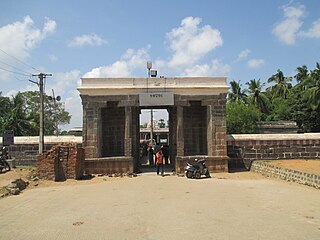
Nithyakalayana Perumal temple in Thiruvidandai, a village in Chennai, Chengalpattu district of the South Indian state of Tamil Nadu, is dedicated to Varaha, the boar avatar of the Hindu god Vishnu. Constructed in the Tamil style of architecture, the temple is glorified in the Naalayira Divya Prabandham, the early medieval Tamil canon of the Alvar saints from the 6th–9th centuries CE. It is one of the 108 Divya Desams dedicated to Vishnu, who is worshipped as Nithyakalayana Perumal (Varaha) and his consort Lakshmi as Komalavalli Thayar. The original structure of the temple was built by the Pallavas during the 7th century CE, with later additions from the Cholas during the 11th century.

























